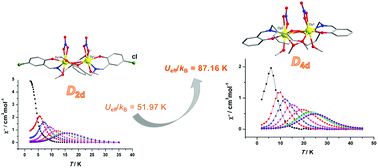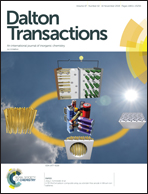Enhanced energy barriers triggered by magnetic anisotropy modulation via tuning the functional groups on the bridging ligands in Dy2 single-molecule magnets†
Abstract
Two dinuclear dysprosium complexes of formulae [Dy2(L1)2(NO3)2(MeOH)2]·2MeOH (1) and Dy2(L2)2(NO3)2(MeOH)2 (2), (H2L1 = 4-chloro-2-(((2-hydroxy-3-methoxybenzyl)imino)methyl)phenol, H2L2 = 2-(((2-hydroxybenzylidene)amino)methyl)-6-methoxyphenol) have been synthesized under solvothermal conditions. The two ligands differ in the substituents at the phenol moieties of the ligands. The purposeful exclusion of the functional group –Cl at the phenol backbone significantly changed the geometries of the metal centers, as evidenced by the X-ray crystallographic analysis. In complex 1, two DyIII ions are in D2d local symmetry, while the DyIII ions of 2 are in D4d local symmetry. Consequently, these two complexes demonstrate distinct magnetic properties. Complexes 1 and 2 both exhibit SMM behavior with energy barriers of 51.97 K for 1 and 87.16 K for 2 under a zero direct-current field. Complete-active-space self-consistent field (CASSCF) calculations were performed on the two Dy2 complexes to rationalize the remarkable observed discrepancy in their magnetic behavior. Theoretical calculations reveal that the angle θ between the magnetic axis and the vector connecting two dysprosium(III) ions is the vital factor for the energy barriers of SMMs. The smaller θ angle of 2 renders it as an SMM with a higher energy barrier. This work demonstrates that tuning the functional groups on the bridging ligands is an effective strategy in modulating the energy barriers of SMMs.



 Please wait while we load your content...
Please wait while we load your content...